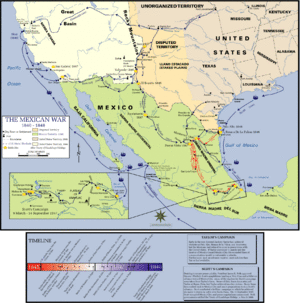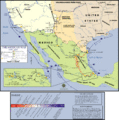Pacific Coast campaign (Mexican–American War) facts for kids
The Pacific Coast Campaign was a series of actions by the United States Navy during the Mexican–American War. It focused on Mexico's Pacific Coast. The campaign did not include battles in California north of the Baja California peninsula.
The main goals were to take control of the Baja Peninsula. Another goal was to stop ships from entering or leaving Mexico's west-coast ports. Mazatlán was a very important port for supplies.
It was hard for the U.S. to achieve these goals at first. Mexican forces in the Los Angeles area resisted strongly. Also, the U.S. Navy did not have enough ships or soldiers. They also lacked supplies. The U.S. Navy tried to blockade the ports three times. They finally succeeded in blocking or taking them over.
Initially, the U.S. easily took La Paz. The governor, Colonel Francisco Palacios Miranda, surrendered. But local people who were loyal to Mexico met and called Miranda a traitor. They started a revolt.
Under new leaders like Mauricio Castro Cota and Manuel Pineda Munoz, these loyal Mexicans tried to push the Americans out. They fought in La Paz and San José del Cabo. Pineda was eventually captured. The Mexican army under Cota was finally defeated at Todos Santos. This happened after the Treaty of Guadalupe Hidalgo was signed. This treaty ended the war. It also returned captured areas south of San Diego to Mexico.
Contents
First Attempts to Blockade Mexico's West Coast
In July and August 1846, Commodore Robert F. Stockton led a campaign. He was the commander of the U.S. Navy Pacific Squadron. On August 17, 1846, he announced that the United States controlled northern California.
Stockton then ordered his ships to blockade Mexican ports. On August 19, the USS Warren was sent to blockade Mazatlan. The Cyane was ordered to blockade San Blas. This port was about 125 miles south of Mazatlan. Stockton also planned to capture Acapulco. He wanted to use it as a base for a joint Army-Navy attack into Mexico.
On September 2, 1846, the Cyane captured two Mexican ships in San Blas harbor. A landing party from the ship then destroyed 34 cannons in the port. On September 7, the Warren captured a Mexican ship called Malek Adhel at Mazatlan.
Stockton had also claimed control of the Baja Peninsula. To make this real, Commander Dupont sailed the Cyane to La Paz. He seized nine small pearl-fishing boats there. He also got a promise from Governor Francisco Palacios Miranda that Baja California would stay neutral. On October 1, the Cyane captured two more ships at Loreto. On October 7, the Cyane fired cannons at Guaymas on the mainland. This happened after Colonel Antonio Campazano refused to surrender the city. A group from the Cyane took a ship called Condor in that port. They found it unusable and burned it.
However, a revolt started in Los Angeles on September 27, 1846. This stopped supplies from reaching the blockade ships. The ships could not stay on station without new supplies. When news of the revolt arrived, the Warren left for San Francisco. On November 13, the Cyane followed. This ended the first blockade of Mexico's west coast after about four weeks.
Second Blockade and Taking Control of Baja California Sur
On December 24, 1846, John Y. Mason, the United States Secretary of the Navy, ordered Commodore Stockton to create a strong blockade. The goal was to stop Mexico from getting weapons and supplies. It also aimed to allow American soldiers to land.
The Battle of La Mesa on January 9, 1847, was the last major fight for California. The U.S. took control of California. This was confirmed when John C. Frémont and Mexican General Andrés Pico signed the Treaty of Cahuenga on January 13, 1847. With California secured, Secretary of War William L. Marcy told General Stephen Watts Kearny to make sure the U.S. control of California was very strong. However, Kearny only had about 100 soldiers and was waiting for more.
On February 3, Commodore Stockton ordered Commander John B. Montgomery to restart the blockade at Mazatlan. He also told him to raise the U.S. flag in San Jose del Cabo, La Paz, Pichilinque, and Loreto. But resistance against the Americans was growing. On February 15, a meeting in Santa Anita declared Governor Miranda a traitor. They named Mauricio Castro Cota as the new governor. Cota tried to gather volunteers, but he was not successful.
On February 17, Montgomery began the blockade of Mazatlan. He did this despite objections from the British. Montgomery then sailed to the Baja California peninsula. He took San Jose del Cabo and San Lucas. But he did not have enough soldiers to set up permanent bases there. On April 14, Montgomery accepted Colonel Miranda's surrender of La Paz. The agreement allowed residents of Baja California who accepted the terms to have the rights of U.S. citizens. They could also keep their own officials and laws.
Luckily for Kearny, more soldiers arrived in San Francisco in March and April. These were the 1st Regiment of New York Volunteers. Commodore William Shubrick, on the Independence, took over from Montgomery on April 26. He restarted the blockade of Mazatlan on April 27, 1847.
On May 30, General Kearny sent Henry Stanton Burton with two companies of New York Volunteers to La Paz. They traveled on the ship Lexington. Burton was to take control of that part of the peninsula. He was also to make sure U.S. laws were followed. On July 15, 115 New York Volunteers landed at La Paz. Burton brought back the local government. He made them promise to be loyal to the United States. The people of La Paz welcomed the Volunteers.
On June 3, the Independence left for San Francisco. The Cyane was the only U.S. Navy warship left on Mexico's west coast. To protect the friendly people of La Paz and San Jose del Cabo, Commander Dupont sailed the Cyane back and forth. This meant the blockade of Mazatlan was broken. When Montgomery met the Cyane at San Jose del Cabo on June 20, he realized Mazatlan was open for trade. After talking with Dupont, Montgomery went back to San Francisco on June 28. He wanted new orders from Commodore Biddle. The Cyane sailed to Hawaii for supplies. The second blockade had failed.
Third Blockade and Revolt in Baja California Sur
Meanwhile, north of La Paz, local priests encouraged ranchers to join the fight against the Americans. In late September, Captain Manuel Pineda Munoz arrived in Mulegé. He brought officers and soldiers from Guaymas. He began recruiting ranchers for his forces.
On August 10, 1847, Commodore Shubrick took command of the Pacific Squadron. His first orders were to send the frigate Congress and the sloops-of-war USS Dale and Portsmouth to start a new blockade. This blockade would target Mazatlán, Guaymas, and San Blas.
On October 2, Mexican and local forces led by Captain Pineda stopped American forces from the USS Dale from taking the small port of Mulegé. This showed the Americans that a serious revolt was starting.
On October 19, Captain Elie A. F. La Vallette threatened to bombard Guaymas with his USS Congress and the Portsmouth. This led to the Mexican soldiers secretly leaving the city and fort on the night of November 19. Colonel Antonio Campuzano led this evacuation. After the morning bombardment, La Vallette landed to take control. He found the city empty of defenders and most of its people.
On November 11, 1847, a large group of U.S. Navy sailors and marines captured Mazatlan without a fight. On November 19–20, 1847, U.S. land forces fought two battles, the Skirmish of Palos Prietos and the Skirmish of Urias. These battles broke up the Mexican forces trying to blockade the city. After this, Mazatlan stayed in American hands for the rest of the war. There were only a few small fights with Mexican forces nearby.
In Baja California Sur, on November 16, Mexican forces under Pineda attacked La Paz. They fought the American soldiers and local people who supported the U.S. But the Americans pushed them back. The next day in Guaymas, Colonel Campuzano tried to take back Guaymas. But a landing party of sailors and marines, supported by the guns of the USS Dale, stopped him. On November 20–21, local forces under José Antonio Mijares were defeated. They tried to capture San José del Cabo from the American soldiers and local militia. From November 27 to December 8, Manuel Pineda surrounded La Paz. The Americans won this siege when the USS Cyane arrived at San José del Cabo.
On January 11, 1848, a landing party from the ship USS Whiton captured the coastal fort of San Blas. They took two cannons and two ships. The port was left defenseless, so the Americans did not occupy the city. A week later, on January 18, Lieutenant Chatard landed a small group at Manzanillo. They disabled three large guns defending the port, making it defenseless.
From January 22 to February 15, Captain Pineda's forces surrounded San José del Cabo. The soldiers defending the city were almost out of food and water. The siege ended when the USS Cyane arrived with more soldiers. Captain Seymour G. Steele led these soldiers. They, along with part of the original defenders, defeated Pineda and broke the siege. Soon after, Lieutenant Colonel Henry Stanton Burton marched out against Pineda. He surprised and captured Pineda at San Antonio.
Burton then marched to Todos Santos. The remaining Mexican forces were gathered there under Governor Cota. On March 31, at the Skirmish of Todos Santos, Burton defeated Cota. This broke up the last Mexican forces. This battle happened after the Treaty of Guadalupe Hidalgo was already signed. But news of the truce had not yet reached them.
Images for kids
See also
 In Spanish: Campaña del Pacífico (Intervención estadounidense en México) para niños
In Spanish: Campaña del Pacífico (Intervención estadounidense en México) para niños



